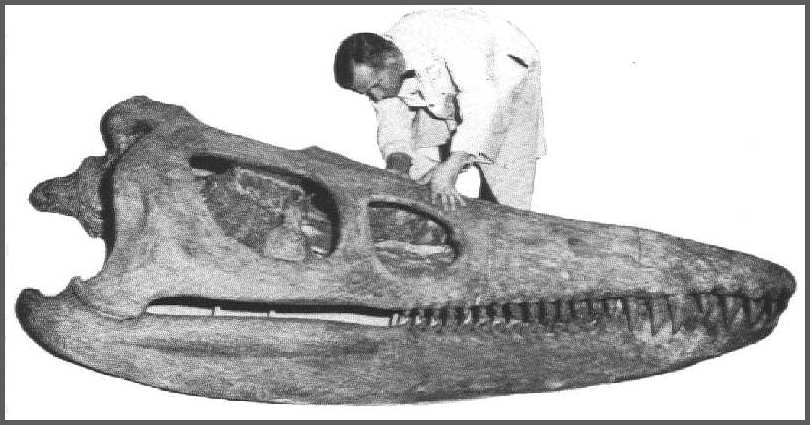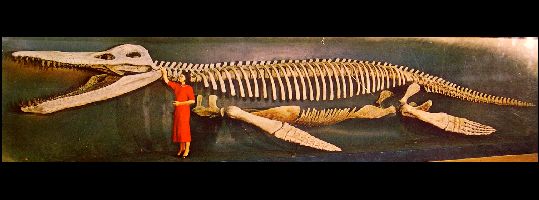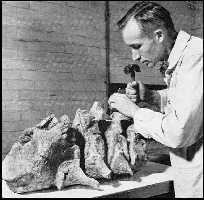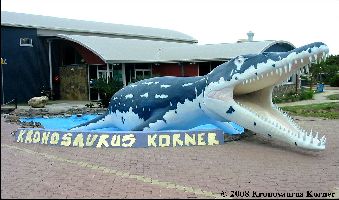 |
Kronosaurus queenslandicus:
Ancient Monarch of the Seas
Copyright by Mike Everhart © 2001-2009
Last revised 01/30/2009
LEFT: This picture shows a preparator
(Arnie Lewis) working on the 9 foot long (2.7 m) skull of Kronosaurus queenslandicus
at the Harvard Museum of Comparative Zoology. Note that this is the original
"smooth" reconstruction of the back of the skull (circa 1957-58), lacking the
parietal crest. Photograph published in the Natural History Magazine, 68:22-23 (January,
1959). |
With almost every fossil discovery, there is
a 'rest of the story' to be told. According to local sources in Australia, Kronosaurus
was originally discovered by a station owner named Ralph William Haslam Thomas. The
remains were dug up by the Harvard expedition after they were shown where it was on his
20,000 acre property "Army Downs" near Hughenden in central Queensland
(Australia). Mr. Thomas apparently had known about a row of vertebrae poking out of the
ground for many years prior to the Harvard expedition. He in turn informed the Harvard
team of its existence.
When it was finally dug up, it was shipped to the United States in 86 cases
weighing approximately 6 tons. The export permit states that the specimen was transported
the SS Canadian Constructor about the 1st of December 1932. After preparation, it
was mounted as an exhibit in the Museum of Comparative Zoology at Harvard.
At 93 years of age, Ralph Thomas finally got to see what he liked to call
"his dinosaur" in its reconstructed state when he visited Harvard. On this
occasion he was reunited with the expedition leader (also quite old) each of whom had
assumed the other to be long dead. The occasion is shown in photos which were published in
a Harvard newsletter at the time.
 |
LEFT: This photo shows the restored skeleton of Kronosaurus
queenslandicus (MCZ 1285) on exhibit at Harvard in 1959. The specimen was said
to be about 42 feet in length, although there is some question regarding the addition of a
number of dorsal vertebrae. |
 |
LEFT: Shaw Studio photograph, undated. |
The following text comes from an article in Natural History
Magazine, June 1959, pp. 22-23:
Ancient Monarch of the Seas
"Fossils are a living, or rather, a dead-reminder to the museum visitor
that the millstones of evolution "grind exceeding slow." But he may not realize,
seeing the finally prepared fossil on display, that museums move rather slowly, too.
If a reminder were needed, Harvard now offers it in a stunning exhibit at the
Museum of Comparative Zoology: a complete skeleton of the giant marine lizard, Kronosaurus
queenslandicus. Between the day when Kronosaurus sank to the bottom of a
Cretaceous ocean and the final installation of his bones at the MCZ, a hundred million
years have elapsed.
 |
The story begins, more precisely, in the Lower Cretaceous, when
sediments drifting down to the ocean bottom entombed the creature's bones in limestone. In
due course, the sea floor became part of continental Australia and the limestone began to
be weathered by wind and water. Through the mantle of rock, bits of Kronosaurus
bones began to appear. These were discovered on a Harvard expedition
to Australia in 1931. Dynamite blasted the rock matrix apart; and the surviving blocks -
weighing in at a total of nearly five tons were shipped to Cambridge. Here, a reversal of
events took place: the reptile was entombed once more, this time in the depths of the
Museum of Comparative Zoology, while the slow work of scientific exposure began. The
reptile's fossilized bones were freed of the surrounding matrix and, after an acid bath,
the ancient creature emerged-twenty-seven years after its arrival in the U.S. |
Kronosaurus is one of the group of plesiosaurs, flesh-eating marine
reptiles which have no real equivalent today and, in their time, had no exact counterpart
on land, either. The plesiosaurs represent one of evolution's about-faces: after life had
moved up from sea to land, this group returned to the ocean. Hence the great paddles they
had for locomotion, and the long necks which enabled most of these massive mariners to
snatch the fish they ate (although Kronosaurus, as it happens, has a short neck,
and apparently made up for this by its very long head).
Why these beasts are called "plesiosaurs" i.e., "near
reptiles," is something of a puzzle - the plesiosaur was thoroughly reptilian in
aspect, and indeed has been described as a "snake, strung through the body of a
turtle"- a statement the accuracy of which may be judged from the new exhibit to be
seen at Harvard."(Go HERE for a detailed explanation fo
this quote)

 |
LEFT: A full
scale, "flesh-on-the-bones" model of Kronosaurus queenslandicus is on
display at the Kronosaurus Korner
complex, located in the heart of Richmond, a town of 750 people in northeast Queensland,
Australia. Richmond is located in
what was a large inland sea covered central Australia during the the latter part of the
Early Cretaceous, and the fossils found around Richmond are the remains of animals that
lived and died in that sea. The Richmond Marine Fossil Museum was built after the 1989
discovery of the "Richmond Pliosaur"
(photo of a cast) at Marathon Station, a property near Richmond. This 100 million-year old
pliosaur was recognized by palaeontologists as one of the best preserved examples of a
pliosaur anywhere in the world. The actual specimen is currently in the Queensland Museum in Brisbane where it is being studied and described. |
The Harvard specimen of Kronosaurus queenslandicus
(KQ) was prepared and mounted by "Dinosaur Jim"- James A. Jensen.
Read about how it was done in the web version of his biography by his son, James R. Jensen
Jr.: Downloadable
PDF file, starting on page 9.
Long (1998, p. 139) notes that Kronosaurus (the Harvard specimen - MCZ
1285) is 12.8 m [42 feet] long as reconstructed.... and that the skull is 2 m long, with
some teeth reaching 30 cm in length (total length.... crown length = 12 cm)
Colin McHenry has examined the Harvard reconstruction and notes (11/2008) that
"the length of the mandible as displayed is 2.6 metres, and the basal skull length
(snout to occiput) is 2.2 m. Bear in mind that the skull was incomplete and the version on
display may not bear much similarity to the original skull size in this specimen."
Suggested references on Kronosaurus and other Cretaceous pliosaurs:
Carpenter, K. 1996. A Review of short-necked plesiosaurs
from the Cretaceous of the western interior, North America, Neues Jahrbuch fuer Geologie
und Palaeontologie Abhandlungen (Stuttgart) 201(2):259-287.
Everhart, M. J. 2007. Historical note on the 1884 discovery of Brachauchenius
lucasi (Plesiosauria; Pliosauridae), Kansas. Kansas Academy of Science, Transactions
110(3-4): 255-258.
Kear, B.P. 2003. Cretaceous marine reptiles of Australia: a review of taxonomy
and distribution. Cretaceous Research 24 (2003) 277–303.
Long, J.A.
1998. Dinosaurs of Australia and New Zealand and other animals of the Mesozoic Era.
University of New South Wales Press, Sydney,188 pp. (Also by Harvard University Press)
Longman, H. A. 1924. Some Queensland fossil vertebrates. Memoirs of the
Queensland Museum 8:16-28.
Longman, H. A. 1930. Kronosaurus queenslandicus. A gigantic Cretaceous
pliosaur. Memoirs of the Queensland Museum 10: 1-7.
Longman, H. A. 1932. Restoration of Kronosaurus queenslandicus. Memoirs
of the Queensland Museum 10:98.
Romer, A. S. and A. D. Lewis. 1959. A mounted skeleton of the giant plesiosaur Kronosaurus.
Breviora 112:1-15.
Schumacher, B.A. 2008. On the skull of a pliosaur (Plesiosauria; Pliosauridae)
from the Upper Cretaceous (Early Turonian) of the North American Western Interior. Kansas
Academy of Science, Transactions 111(3-4):203-218.
Schumacher, B. A. and M. J. Everhart. 2005. A stratigraphic and taxonomic
review of plesiosaurs from the old Fort Benton Group of central Kansas: A new assessment
of old records. Paludicola 5(2):33-54.
White, T. E. 1935. On the skull of Kronosaurus queenslandicus Longman.
Occasional Papers of the Boston Society of Natural History 8: 219-228.
White, T. E. 1940. Holotype of Plesiosaurus longirostris Blake and
classification of the plesiosaurs. Journal of Paleontology 14: 451-467.
Williston, S. W. 1907. The skull of Brachauchenius, with special
observations on the relationships of the plesiosaurs. United States National Museum
Proceedings 32:477-489. pls. 34-37.
LINKS:
Mesozoic Monsters of the Mangahouanga
(New Zealand)
Something about
pliosaurs
Kansas
Plesiosaurs (including pliosaurs)
BACK TO INDEX





